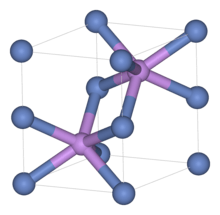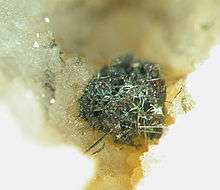Nickel sulfide
Nickel sulfide is an inorganic compound with the formula NiS. It is a black solid that is produced by treating nickel(II) salts with hydrogen sulfide. Many nickel sulfides are known, including the mineral millerite, which also has the formula NiS. Aside from being useful ores, nickel sulfides are the products of desulfurization reactions, and are sometimes used as catalysts. Nonstoichiometric forms of nickel sulfide are known, e.g., Ni9S8 and Ni3S2.
 | |
| Names | |
|---|---|
| IUPAC name
Nickel(II) sulfide | |
| Other names
nickel sulfide, nickel monosulfide, nickelous sulfide | |
| Identifiers | |
3D model (JSmol) |
|
| ChemSpider | |
| ECHA InfoCard | 100.037.113 |
| EC Number |
|
PubChem CID |
|
| RTECS number |
|
CompTox Dashboard (EPA) |
|
| |
| Properties | |
| NiS | |
| Molar mass | 90.7584 g mol−1 |
| Appearance | black solid |
| Odor | Odorless |
| Density | 5.87 g/cm3 |
| Melting point | 797 °C (1,467 °F; 1,070 K) |
| Boiling point | 1,388 °C (2,530 °F; 1,661 K) |
| insoluble | |
| Solubility | soluble in nitric acid |
| +190.0·10−6 cm3/mol | |
| Structure | |
| hexagonal | |
| Hazards | |
| Main hazards | may cause cancer by inhalation |
| GHS pictograms |  |
Except where otherwise noted, data are given for materials in their standard state (at 25 °C [77 °F], 100 kPa). | |
| Infobox references | |
Structure
Like many related materials, nickel sulfide adopts the nickel arsenide motif. In this structure, nickel is octahedral and the sulfide centers are in trigonal prismatic sites.[1]
Nickel sulfide has two polymorphs. The α-phase has a hexagonal unit cell, while the β-phase has a rhombohedral cell. The α-phase is stable at temperatures above 379 °C (714 °F), and converts into the β-phase at lower temperatures. That phase transition causes an increase in volume by 2-4%.[2][3][4]
Synthesis
The precipitation of solid black nickel sulfide is a mainstay of traditional qualitative inorganic analysis schemes, which begins with the separation of metals on the basis of the solubility of their sulfides. Such reactions are written:[5]
- Ni2+ (aq) + H2S (aq) → NiS (s) + 2 H+ (aq)
Many other more controlled methods have been developed, including solid state metathesis reactions (from NiCl2 and Na2S) and high temperature reactions of the elements.[6]
Occurrence
Natural
The mineral millerite is also a nickel sulfide with the molecular formula NiS, although its structure differs from synthetic stoichiometric NiS due to the conditions under which it forms. It occurs naturally in low temperature hydrothermal systems, in cavities of carbonate rocks, and as a byproduct of other nickel minerals.[7]

In glass manufacturing
Float glass contains a small amount of nickel sulfide, formed from the sulfur in the fining agent Na
2SO
4 and the nickel contained in metallic alloy contaminants.[8]
Nickel sulfide inclusions are a problem for tempered glass applications. After the tempering process, nickel sulfide inclusions are in the metastable alpha phase. The inclusions eventually convert to the beta phase (stable at low temperature), increasing in volume and causing cracks in the glass. In the middle of tempered glass, the material is under tension, which causes the cracks to propagate and leads to spontaneous glass fracture.[9] That spontaneous fracture occurs years or decades after glass manufacturing.[8]
References
- Wells, A.F. (1984) Structural Inorganic Chemistry, Oxford: Clarendon Press. ISBN 0-19-855370-6.
- Bishop, D.W.; Thomas, P.S.; Ray, A.S. (1998). "Raman spectra of nickel(II) sulfide". Materials Research Bulletin. 33 (9): 1303. doi:10.1016/S0025-5408(98)00121-4.
- "NiS and Spontaneous Breakage". Glass on Web. Nov 2012. Archived from the original on 2013-06-12.
- Bonati, Antonio; Pisano, Gabriele; Royer Carfagni, Gianni (12 October 2018). "A statistical model for the failure of glass plates due to nickel sulfide inclusions". Journal of the American Ceramic Society. doi:10.1111/jace.16106.
- O.Glemser "Nickel Sulfide" in Handbook of Preparative Inorganic Chemistry, 2nd Ed. Edited by G. Brauer, Academic Press, 1963, NY. Vol. 2. p. 1551.
- leading reference can be found in: Shabnam Virji, Richard B. Kaner, Bruce H. Weiller "Direct Electrical Measurement of the Conversion of Metal Acetates to Metal Sulfides by Hydrogen Sulfide" Inorg. Chem., 2006, 45 (26), pp 10467–10471.doi:10.1021/ic0607585
- Gamsjager H. C., Bugajski J., Gajda T., Lemire R. J., Preis W. (2005) Chemical Thermodynamics of Nickel, Amsterdam, Elsevier B.V.
- Karlsson, Stefan (30 April 2017). "Spontaneous fracture in thermally strengthened glass - A review & outlook". Ceramics - Silikaty: 188–201. doi:10.13168/cs.2017.0016. Retrieved 16 August 2019.
- Barry, John (12 January 2006). "The Achille Heel of a Wonderful Material: Toughened Glass". Glass on Web. Retrieved 16 August 2019.